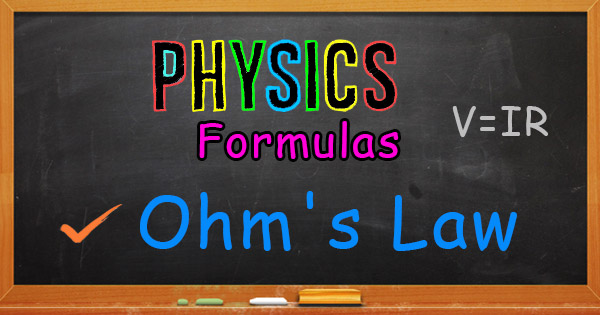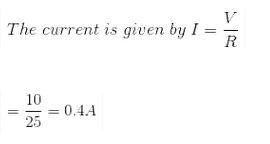
Ohm’s law says that the current running through the conductor is directly proportional to the potential difference across its extremities as long as the temperature and other physical conditions are constant.
Ohm’s Law Formula is articulated as V=IR
Where,
Voltage is V and is measured in Volts,
The current flowing through the conductor is I and it represented in amperes,
the resistance is R and is measured in ohms
Ohm’s law formula (potential difference formula) is made use of to calculate the Resistance,Current and Voltage in any given circuit if any of the two quantities are given.
Check the list of all Physics Formulas here. For Biology, Chemistry, Physics, Maths, English, GK etc please check respective sections of CheckAll.in. You can now subscribe here for free, to get notification regarding new posts.
Here are some exercise problems with solutions for you.
Solved Problems on Ohm’s Law
Problem 1: A potential difference of 10 V is applied across a conductor whose resistance is 25 ω. Calculate the current flowing through it?
Answer:
Given: Potential difference V = 10 V,
Resistance R = 25 ω,

Problem 2: If a conductors conductance is 60 ω and current passing through the is 4 A. Calculate the potential difference?
Answer:
Current I = 4 A,
Resistance R = 60 ω,
Potential difference V = IR
= 4A × 60 ω
= 240 v.
Problem 3: An emf source of 6.0V is connected to a purely resistive lamp and a current of 2.0 amperes flows. All the wires are resistance-free. What is the resistance of the lamp?
Hints
Where in the circuit does the gain in potential energy occur?
Where in the circuit does the loss of potential energy occur?
What is Ohm’s Law?
Answer:
The gain of potential energy occurs as a charge passes through the battery, that is, it gains a potential of =6.0V. No energy is lost to the wires, since they are assumed to be resistance-free. By conservation of energy, the potential that was gained (i.e. =V=6.0V) must be lost in the resistor. So, by Ohm’s Law:
V = I R
R=V/I
R = 3.0
Problem 4:If a circuit has a resistance of 18 Ω and a current of 15 A, what is the voltage?
This is practice question for you. Write your answer on the comments section below.